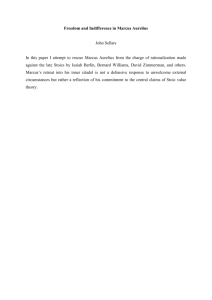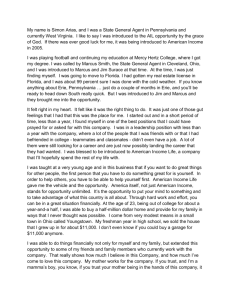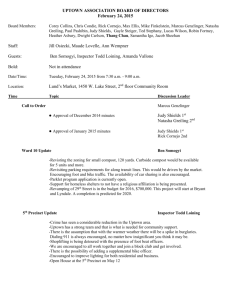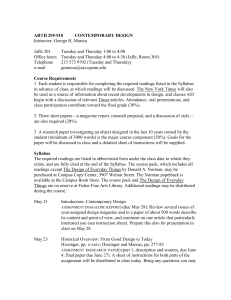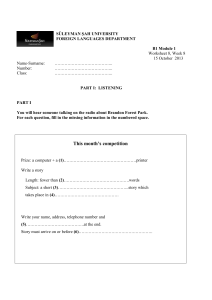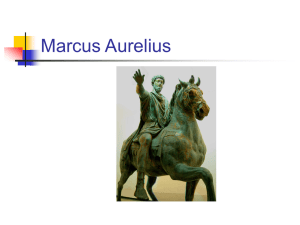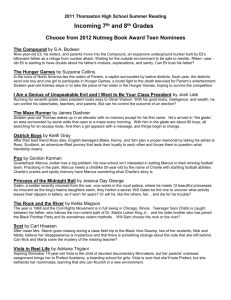Animal Rights & Pet Privileges in Reggio Emilia
advertisement
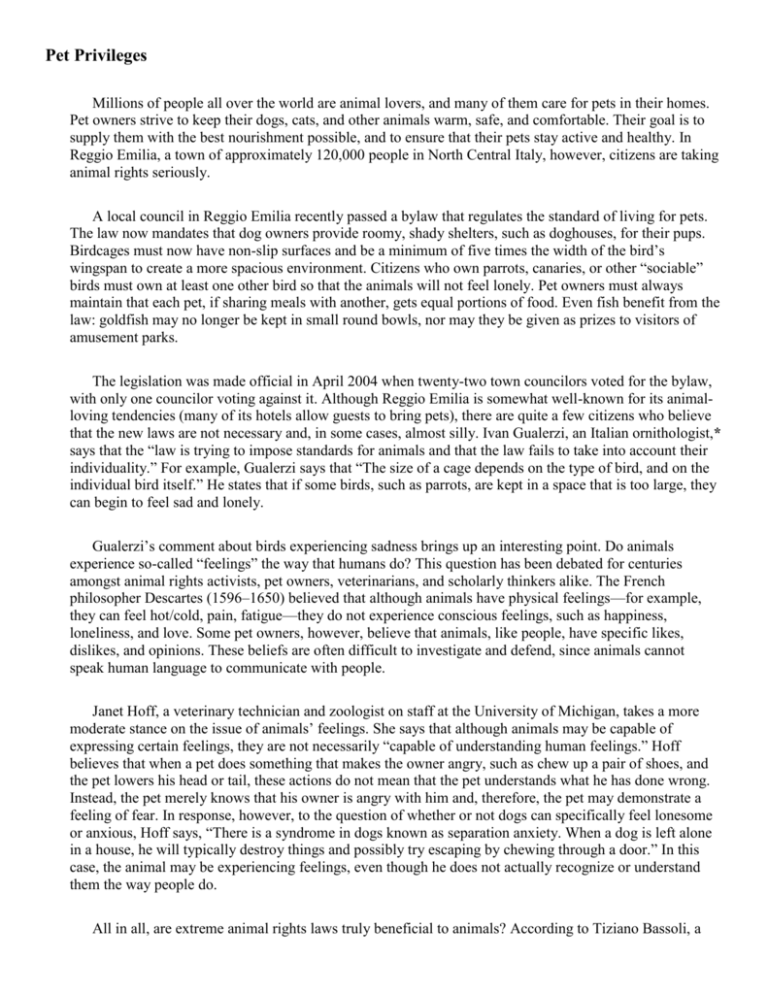
Pet Privileges Millions of people all over the world are animal lovers, and many of them care for pets in their homes. Pet owners strive to keep their dogs, cats, and other animals warm, safe, and comfortable. Their goal is to supply them with the best nourishment possible, and to ensure that their pets stay active and healthy. In Reggio Emilia, a town of approximately 120,000 people in North Central Italy, however, citizens are taking animal rights seriously. A local council in Reggio Emilia recently passed a bylaw that regulates the standard of living for pets. The law now mandates that dog owners provide roomy, shady shelters, such as doghouses, for their pups. Birdcages must now have non-slip surfaces and be a minimum of five times the width of the bird’s wingspan to create a more spacious environment. Citizens who own parrots, canaries, or other “sociable” birds must own at least one other bird so that the animals will not feel lonely. Pet owners must always maintain that each pet, if sharing meals with another, gets equal portions of food. Even fish benefit from the law: goldfish may no longer be kept in small round bowls, nor may they be given as prizes to visitors of amusement parks. The legislation was made official in April 2004 when twenty-two town councilors voted for the bylaw, with only one councilor voting against it. Although Reggio Emilia is somewhat well-known for its animalloving tendencies (many of its hotels allow guests to bring pets), there are quite a few citizens who believe that the new laws are not necessary and, in some cases, almost silly. Ivan Gualerzi, an Italian ornithologist,* says that the “law is trying to impose standards for animals and that the law fails to take into account their individuality.” For example, Gualerzi says that “The size of a cage depends on the type of bird, and on the individual bird itself.” He states that if some birds, such as parrots, are kept in a space that is too large, they can begin to feel sad and lonely. Gualerzi’s comment about birds experiencing sadness brings up an interesting point. Do animals experience so-called “feelings” the way that humans do? This question has been debated for centuries amongst animal rights activists, pet owners, veterinarians, and scholarly thinkers alike. The French philosopher Descartes (1596–1650) believed that although animals have physical feelings—for example, they can feel hot/cold, pain, fatigue—they do not experience conscious feelings, such as happiness, loneliness, and love. Some pet owners, however, believe that animals, like people, have specific likes, dislikes, and opinions. These beliefs are often difficult to investigate and defend, since animals cannot speak human language to communicate with people. Janet Hoff, a veterinary technician and zoologist on staff at the University of Michigan, takes a more moderate stance on the issue of animals’ feelings. She says that although animals may be capable of expressing certain feelings, they are not necessarily “capable of understanding human feelings.” Hoff believes that when a pet does something that makes the owner angry, such as chew up a pair of shoes, and the pet lowers his head or tail, these actions do not mean that the pet understands what he has done wrong. Instead, the pet merely knows that his owner is angry with him and, therefore, the pet may demonstrate a feeling of fear. In response, however, to the question of whether or not dogs can specifically feel lonesome or anxious, Hoff says, “There is a syndrome in dogs known as separation anxiety. When a dog is left alone in a house, he will typically destroy things and possibly try escaping by chewing through a door.” In this case, the animal may be experiencing feelings, even though he does not actually recognize or understand them the way people do. All in all, are extreme animal rights laws truly beneficial to animals? According to Tiziano Bassoli, a songbird breeder in Reggio Emilia, “The spirit of the law is good, but in practical terms, it’s exaggerated and a bit of a mess.” No matter what position one takes regarding whether or not animals are capable of experiencing true feelings, one thing is for certain: The citizens of Reggio Emilia, Italy, intend to treat their pets with the utmost respect. *ornithologist: one who studies birds 1. With which statement would Descartes most likely agree? A. Animals have feelings just like people. B. Animals do not have any kind of feelings. C. Animals are capable of making moral choices. D. Animals have physical feelings but not emotions. 2.. Why does Janet Hoff mention separation anxiety? A. to show why animals must always be bought in pairs B. to explain how humans depend on animal companions C. to give an example of how animals seem to experience feelings D. to demonstrate why people should never leave dogs alone at home 3. In paragraph 3, when Ivan Gualerzi says, “The size of a cage depends on the type of bird,” what point is he supporting? A. The legislation is misguided. B. The legislation is very important. C. The legislation is no longer needed. D. The legislation does not go far enough. 4. Which statement describes the main idea of paragraph 2? A. Goldfish may not be given away as prizes. B. The law regulates living conditions for pets. C. The assumption that goldfish have feelings is incorrect. D. Pet owners believe that animals can communicate with humans. 5. Which would be the best row and column heading to use in a chart to summarize the information in Paragraph 2? A. name of owner, number of pets B. type of animal, standard of living C. geographical region, owner-pet relations D. level of government, detail of legislation 6. By covering the topic of animal rights in this format instead of in a news article format, what is the benefit to the audience? A. They read more expert comments. B. They read only one side of the issue. C. They read multiple sides of the issue. D. They read many more specific details. Book on the Bus Another day, another trip on the bus. That’s how it was for this ordinary paperback, and it was grateful for its present situation. After the first reader had thumbed through the story from cover to cover, times became unpredictable. Life was grand when the book was new and sitting on the shelf of a respectable bookstore. The covers were pristine then, with shiny new words on the outside, each inside page still crisp with bright white paper and jet-black ink, the top corner of each page still straight and perfect. There was the distinct freshfrom-the-printer cologne lingering in the air. How many readers ago had that been? Its covers were fraying around the edges now, wrinkling badly along the spine. Someone had set a cold glass on its back cover once, using it as a coaster on a warm day. The droplets of moisture had trickled down the sides of the glass, gathered in a perfect circle, and raised an ugly ring which permanently marked the spot. There were dog-eared corners creasing its pages, marking the spot where certain readers paused in their reading. And there were tooth marks on its front cover left by an infant who regarded it as a convenient teething toy. Such maltreatment was enough to dismay any self-respecting paperback. Following its foray into family situations, it was placed on the shelf of a secondhand bookstore. Hope soared with this change in fortune, restoring self-respect. Such optimism was short-lived, however, when it was stuffed into a bulging backpack and carried off to college with three other paperbacks. It was bounced, jostled, and shoved aside rudely whenever the heavier textbooks were withdrawn from the backpack. When it was finally pulled from that cramped, dark cavern, it was dropped unceremoniously onto a hard surface littered with stale food crumbs and wooden pencils bearing deep gnaw marks. Under a narrow shaft of light surrounded by darkness, its pages were frequently opened only to fall face-down onto a soft material that heaved up and down slowly for hours on end. The book was passed from one pair of hands to another and stuffed into a variety of backpacks, some less cramped than others, until it landed in the present situation. The backpacks were replaced by an orderly briefcase, and when the book was taken out it was often placed on clean, smooth surfaces or held firmly by hands that respected the pages. Of course there was a bit of jostling at times, sudden lurches upward or sideways. Being read on a bus was no steady affair, but at the end of each ride the book was placed respectfully back into the briefcase. Until today. There were the usual jostles with the upward and sideways lurches. The book was used to those movements, but today it was snapped shut suddenly and banged against the hard edges of the briefcase. The book was banged so violently that instead of a short fall into darkness, it plummeted a long way down onto a hard, grooved surface mottled with odd shadows. This wasn’t the orderly inside of the briefcase. Where was the familiar darkness, the rhythmic cradle-rock, the gentle thud that meant it was at work or home? Something was wrong. Something was terribly wrong! In an instant, the book slid backward along the grooved surface, bumping against metal struts, halting briefly on sticky patches, rolling over flattened clots of mud, and snagging a discarded cellophane wrapper between its pages along the way. The sliding stopped abruptly. The book was relieved to be stationary until it felt a steady vibration in the floor. For several moments the vibration hummed and then the sliding began again. The floor tilted forward at a steep angle and with the captured cellophane wrapper still between the pages, the book slid over the grooves it had just traversed. It rolled back over the flattened clots of mud, halted briefly on the sticky patches, and careened off metal struts until it slammed into an unyielding wall of plastic. It rode that way, pressed firmly against the plastic, until the dizzying tilt of the floor leveled back to horizontal and the bus stopped once more. Again it felt the odd vibration as shadows flitted about in an uneven pattern. Then the shadows ceased and the bus moved on. A hand wrapped around the book, lifted it from the floor, opened the front cover, and traced a finger down the length of the blank fly page. The hand closed the cover, then opened the book to where the captive cellophane clung limply to the page edges. What a relief to have the litter removed! No self-respecting paperback wanted a rag-tag bit of wrapper hanging from it! To its horror, the cellophane was smoothed neatly and placed securely between its pages as a bookmark before the book was shut once more and then held high in the air. Another pair of hands reached out, wrapping around the book and thumbing through the pages hastily. Hand after hand repeated the process, passing the book from one end of the bus to the other. And each time a finger pushed against the cellophane wrapper, locking it securely between the pages. As the bus ground to a third halt, the book was tossed roughly onto an empty seat. It felt the vibration again, fainter this time, as shadows flitted above it. One shadow in particular loomed over it, abruptly plunging it into darkness with a sudden weight pressing down. The weight lifted as rapidly as it had descended, the darkness retreated instantly, and a hand flung the book to another empty seat. The process repeated itself for longer than the book cared to endure: hands thumbing its pages, fingers securing the cellophane bookmark, shadows flitting over it until one more hand lifted the book from the empty seat. It squeezed the book’s cover firmly, shook it up and down vigorously, and removed the cellophane wrapper before tucking it respectfully into the familiar darkness of an orderly briefcase. 7. What is the main idea of paragraph 3? A. Who has read the book. B. How far the book has traveled. C. How the book became so worn. D. Who noticed the book was damaged. 8. What is being described about the book in paragraphs 7 and 8? A. how it is being dragged across the street. B. how it is moving over the floor of the bus. C. how it is being kicked along on the ground. D. how it is bouncing in the owner’s briefcase. 9. What does the speaker achieve with the description of its trip on the bus? A. The reader gets to see how easy it is to lose a book B. A connection is forged with the audience to understand what a book goes through during its lifetime. C. The reader feels sorry that the passengers have to ride for so long. D. The reader figures out that the owner of the book lost it. 10. How does the author's use of personification in the text assist the reader with determining the theme? A. It emphasizes how people mistreat books. B. It emphasizes how long people keep books. C. It emphasizes the fact that the more people that read a book, the longer a books life will be. D. It emphasizes how people should read on long bus rides. 11. What is the main idea of paragraph 3? A. Who has read the book. B. How far the book has traveled. C. How the book became so worn. D. Who noticed the book was damaged. 12. Which of these could be best considered the antagonist in the story? A. Non readers B. Bus drivers C. Careless people D. Bookstore clerks 13. How does the author organize this passage? A. By describing different ways that people treat books B. By contrasting one book's experiences with that of another C. By giving a chronological account of what happens to a book D. By describing a problem the book faces then giving its solution 14. What is being described about the book in paragraphs 7 and 8? A. How it is being dragged across the street B. How it is moving over the floor of the bus C. How it is being kicked along the ground D. How it is bouncing in the owner's brief case No Sight of Shore In 1997, Dr. Robert Ballard and a team of scientists discovered a large collection of ancient ships, including a Roman ship over two thousand years old, lying where they least expected . . . at the bottom of the ocean floor in the middle of the Mediterranean Sea. Until this discovery, archaeologists believed that ancient sailors never ventured into open water and that all sailing was done with the coastline in view. Most of the cargo of the ship was still intact and revealed an amazing look at the variety of trade items the ancient sailors transported by sea. This story was inspired by the discovery. September wasn’t a good month for sailing to Carthage, but Marcus had begged to be allowed to travel with his Uncle Julian; it would have been ungrateful of him to back out when the invitation finally came. Of course, Marcus had made his plea to sail with the crew during the lazy summer months when sailing across open ocean was little more than a novel way to travel to an exotic land. Marcus gripped the railing at the stern of the ship as he looked eastward and felt his stomach sink. The morning sky glowed as though red paint had been spilt across the horizon. “Red sky at morning . . . ” he muttered to himself, unwilling to give breath to the rest of the ominous rhyme: sailor take warning. “Marcus!” His uncle’s voice was gruff and short-tempered. “Secure those jars. There’s weather brewing and I won’t have my cargo being banged about because of it.” Marcus bent and pulled against the ropes running through the handles of the amphorae* tied along the deck. The smell of olive oil permeated the clay jars as he nudged their rounded sides closer together and tightened the ropes. He tugged along yards of rope as he worked his way down the cramped deck. He rose up slightly, turning his head away from a nose-wrinkling smell. Two rows of amphorae containing fish sauce had been added to the cargo at the last minute with nowhere but topside to store them. If there was an inch of unoccupied space on the ship, Uncle Julian considered it a loss of profits. Olive oil and fresh fruits sealed in the amphorae were tolerable as far as Marcus was concerned. They were commodities householders and shopkeepers alike paid good coins for. But fish sauce was the most sought-after condiment. It commanded the highest price across the market, and Uncle Julian always kept his eye to profits. “Good merchandise and fast delivery” were his watchwords. Marcus wished “good merchandise” didn’t include fish sauce. Marcus strained against the last knot of rope that secured the final jar tightly against its neighbor before he noticed the strangeness. The hundred-foot-long deck was nearly deserted. He stood and wiped the sweat trickling down the sides of his face as he looked eastward once more. The air seemed to begrudge each breath Marcus drew, and overhead, dove gray clouds were stretching toward the ship like the first foam of a beach wave. He felt a hand on his shoulder. “Now get below in the aft cargo hold. Help Agricola and Antoninus get those kitchenwares stowed properly before that storm hits; you’re wasting precious time just standing here,” his uncle growled. Marcus cast a quick glance at the horizon. His head swiveled in a half circle in each direction but his eyes met with nothing more than the endless stretch of the sea. “No sight of shore,” he whispered as he fought against rising panic while making his way below. The air below reeked of sweat, metal, and other odors he didn’t care to identify. If the air on deck had been stifling, the atmosphere below deck threatened suffocation. Hushed and gloomy voices muttered orders and Marcus lent his hands to the task. When he ventured a question about the strange weather, he was ordered to pack more straw around the bronze cooking pots. Such reticence from the generally talkative crewmembers unnerved Marcus. The first waves bumped the ship roughly. Marcus didn’t need Agricola’s hurried suggestion to scramble up onto deck. He searched nervously for his uncle but was ordered to remain beside the mast and out of the way of the crew. Men shoved each other along as they scurried over the deck. Marcus wrapped an arm around the mast to steady himself as the sea heaved violently and thunder exploded overhead. Rain, thrown horizontal by the sudden wind, stung Marcus’s eyes as he squinted toward the horizon. He turned his head away from the piercing rain and looked westward. There was nothing to guide them to safe harbor, no strong and steady hump of hills beckoning them to the safety of land. Darkness descended, lightning stabbed, wind screamed, and waves tried to tear him from the mast. Through it all Marcus couldn’t distinguish between the angry rolls of thunder and the threatening groans of ship’s timbers. What had been a solidly built vessel moments before suddenly felt like a flimsy child’s toy splashed about by an angry youngster. Marcus hugged the mast fiercely, sickened by the thought they would be forever lost at sea in such a storm. Through the storm’s rage he watched helplessly as crewmembers withdrew knives and began sawing through ropes he had tightened barely hours ago. Agricola, Antoninus, and others frantically tossed amphorae overboard in an effort to lighten the ship while Marcus’s uncle shouted orders. The storm pushed the ship along in a crazy up and down dance for half a day then subsided as suddenly as it began. The silence hurt the ears as much as the storm-roar had. Marcus could barely hold his eyes open against the eye-searing brilliance of sunlight glancing off the wet deck. Then came the unexpected sound: Marcus heard his uncle laugh, heartily at first, then uproariously. “Ha!” Uncle Julian snapped his fingers in the air. “We live to sail another day! Though perhaps we’ll be a little poorer than we planned,” he added regretfully. Marcus studied his uncle as he approached. “Are you alright, boy?” a great hand slapped Marcus’s shoulder sympathetically. Marcus shrugged as he looked toward the horizon. “Are we lost now, Uncle?” “Lost?” Uncle Julian followed Marcus’s gaze. “No, boy, we’re not lost. It’s just not time to see the shore yet. Is that what was worrying you all this time?” Marcus bowed his head a moment before looking into his uncle’s eyes. “Not anymore. But I am looking forward to seeing land again, just to know that it’s still there.” *amphorae: large ceramic jars with pointed bottoms 15. What is the main idea of paragraph 4? a. b. c. d. The approach of the storm The contents of the amphorae Uncle Julian’s wish for profits Marcus’s efforts to tighten the ropes 16. What does the first paragraph of the passage set to achieve? a. b. c. d. To summarize the story before it is told in detail To set the context of the story To justify the actions in the story To introduce the narrator of the story 17. In paragraph 11, why does Marcus’ uncle say that they will be “a little poorer” than expected? a. b. c. d. They had to throw some cargo overboard because of the storm. They will have to pay Marcus for his work on the ship. The storm caused a tremendous amount of damage to the ship. The trip to Carthage will be long and expensive for the crew. 18. Based on paragraph 3, you can conclude that Uncle Julian is: a. b. c. d. Businesslike and focused on making a profit Hesitant to have Marcus working on the ship Lighthearted, especially with his nephew Worried about the storm 19. Which phrase from the passage is an example of personification? a. b. c. d. It commanded the highest price across the market… …as though red paint had been split across the horizon. The air seemed to begrudge each breath Marcus drew. Marcus could barely hold his eyes against the eye-searing brilliance of sunlight… 20. What does the author achieve using personification to describe the approaching weather? a. b. c. d. The reader is provided with a direct image of the setting. The reader experiences the intense movement of the sea. The narrator gives rhythm to the sea. The narrator shows expresses Marcus’ alarm. 21. Which sentence best foreshadows the coming storm? a. Of course, Marcus had made his plea to sail with the crew during the lazy summer months. b. Marcus gripped the railing at the stern of the ship as he looked eastward and felt his stomach sink. c. “Red sky at morning…” he muttered to himself, unwilling to give birth to the rest of the ominous rhyme: sailor take warning. d. September wasn’t a good month for sailing to Carthage, Marcus had begged to be allowed to travel with his Uncle Julian; it would have been ungrateful of him to back out when the invitation finally came. Walter Simmons Edgar Lee Masters My parents thought that I would be As great as Edison or greater: For as a boy I made balloons And wondrous kites and toys with clocks And little engines with tracks to run on And telephones of cans and thread. I played the cornet and painted pictures, Modeled in clay and took the part Of the villain in the “Octoroon.” But then at twenty-one I married And had to live, and so, to live I learned the trade of making watches And kept the jewelry store on the square, Thinking, thinking, thinking, thinking,— Not of business, but of the engine I studied the calculus to build. And all Spoon River watched and waited To see it work, but it never worked. And a few kind souls believed my genius Was somehow hampered by the store. It wasn’t true. The truth was this: I didn’t have the brains. 22. Which reading strategy would most help a reader to understand the tone of this poem? A. reading the poem out loud B. skimming the poem quickly C. rereading the poem several times D. drawing a picture inspired by the poem 23. What theme is addressed in this poem? A. the conflict between dreams and reality B. the anger of children towards their parents C. the struggle to overcome physical limitations D. the importance of gaining money and power at work 24. What common American idea is reflected in this poem? A. Working hard is important for happiness. B. Earning money is the way people earn respect. C. All parents think their children are exceptional. D. Physical work is something that should be avoided. 25. What best describes the author’s purpose in writing this poem? A. to encourage readers to try inventing something B. to inspire readers to write poetry about their own childhoods C. to get readers to think about what makes someone successful D. to criticize parents who have high expectations for their children Essay Questions: 26. Identify the text structure and main idea of paragraph four in the essay Pet Privileges. Use appropriate textual citations to defend your answer. Then, discuss how the main idea of paragraph four supports the main idea of the overall piece. RUBRIC: In order to score a 4, the student must: 1. Identify the text structure of paragraph four (compare/contrast) AND provide two examples of text citations (that reflect similarities and differences) 2. Identify the main idea of paragraph four AND provide an example of textual citation that reflects main idea 3. Discuss overall main idea of piece 4. Discuss how the main idea of paragraph four supports the main idea of the overall piece In order to score a 3, students must complete 3 of the 4 items. In order to score a 2, students must complete 2 of the 4 items. In order to score a 1, students must complete 1 of the items. A score of N/S reflects work that does not fit the assigned task. 27. Choose a character from either “No Site of Shore” or “Walter” who you feel is responsible for driving the conflict of his/her story. Using textual citations identify the conflict and discuss how the character’s traits, motivations, and actions that developed that conflict from beginning to end. In order to score a 4, the student must 1. 2. 3. 4. Identify a character that is relevant to a conflict that takes place in one of the pieces Describe a conflict and resolution from one of the pieces, using textual citations Describe that character’s traits, motivations, and actions using textual citations Discuss how the character drove the conflict through traits, motivations, and actions
